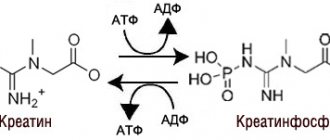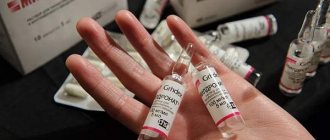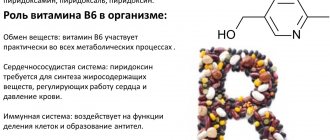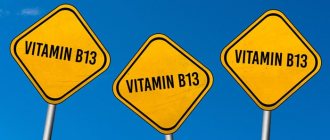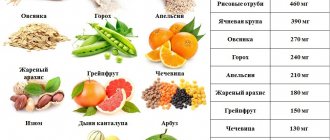Every person who loves his job strives for perfection in it. Athletes, both professional and amateur, are no exception. They expect results from their efforts - increased muscle mass and strength, good endurance.
There are effective and safe means that help you achieve the necessary heights in the sports niche. One of these products will be the subject of today's conversation.
What it is?
Creatine is a compound of non-protein substances that need to be eliminated from the body.
The biochemistry of creatinine metabolism is closely related to the following substances:
- Ammonia,
- Uric acid,
- Urea.
Few people know what creatinine is. The chemical type of this element is C4H7N3O. It is a by-product of protein metabolism. This means that creatinine standards are a mirror reflection of the process of nitrogen removal from the body.
The main site of creatinine formation is considered to be skeletal muscles; in small quantities it is found in the brain. The source of formation is creatine phosphate. Where does it come from?
Creatine is considered the start of this protein reaction.
It begins its journey in the renal parenchyma. Creatine conversion occurs in the liver.
It is then transported to the muscles. Here creatine phosphate is created from it, and then it is sent to myofibrils. A breakdown reaction occurs, one of the substances being creatinine. As a result, the energy necessary for muscle contraction is released. Creatinine enters the blood, through which it is delivered to the kidneys. C4H7N3O is excreted from the body along with urine.
This energy exchange occurs constantly. What does it mean? This suggests that the level of this substance in the blood is unchanged in a healthy person.
So far, scientists have not found evidence that creatinine is toxic, although it is classified as a secondary metabolite that must be eliminated from the body.
An increase in creatinine in the blood is a consequence of changes in kidney function. In diagnosis, a creatinine test is often used, in particular the Rehberg test. This, in other words , is a calculation of creatinine clearance. To do this, the amount of this substance in the blood is determined and what part of it is excreted in the urine.
https://youtu.be/huizRrCG_Ik
Biochemistry and physiology
Creatine is an essential natural substance (methyl guanidoacetic acid) that is found in the muscles of humans and animals and is required for energy metabolism, muscle movement and overall functioning. The human body contains about 100-140 g of this substance, which acts as a source of energy for muscles. The daily consumption of creatine under normal conditions is approximately 2 g.
Creatine is as important to life as protein, carbohydrates, fats, vitamins and minerals. Without creatine, people and animals could not live. Creatine deficiency is associated with several physical and muscle disorders.
The human body synthesizes creatine from three amino acids: glycine, arginine and methionine. In humans, the enzymes involved in creatine synthesis are localized in the liver, pancreas and kidneys. Creatine can be produced in any of these organs, and then transported by the blood to the muscles. Approximately 95% of the total creatine reserve is stored in skeletal muscle tissue. The remaining 5% is found in the heart, brain and testes. The total pool (reserve) of creatine in humans consists of creatine in free form and in the form of phosphocreatine. In skeletal muscle tissue, phosphocreatine makes up two-thirds of the total creatine pool, with the rest being free forms of creatine.
In the absence of exogenous (obtained from the diet) creatine, the rate of excretion as creatinine in humans is about 1.6% per day. Thus, with a body weight of 70 kg and a total creatine reserve of 140 g, a person will lose approximately 2 g of creatine per day during normal household activities. As physical activity increases, creatine turnover also increases, and its supply must be replenished through diet or through the body's own natural production. Dietary creatine is found primarily in meat, fish and other animal products.
Plants contain only trace amounts. The average daily diet of meat and vegetables contains approximately 1 g of creatine. Since the daily need for creatine can only be partially covered by diet, the rest is forced to be synthesized by the body itself. The resulting creatine enters the muscles through the bloodstream, where, under the influence of the enzyme creatine kinase, it is converted into creatine phosphate. Creatine phosphate accumulates in the cell as a source of chemical energy for adenosine triphosphate (ATP). After the release of phosphate, creatine is converted into creatinine, which is excreted through the kidneys as waste.
However, a vegetarian’s daily need for creatine can only be met through endogenous (passing inside the body) synthesis, and this amount is sometimes simply catastrophically insufficient.
Here are the approximate levels of creatine in foods (in grams of creatine per 1000 g food source): shrimp - traces, cod - 3 g, herring - 6.5-10 g, salmon - 4.5 g, tuna - 4 g, beef - 4 .5 g, pork – 5 g, milk – 0.1 g, cranberry – 0.02 g. Now you can conclude for yourself that animal food sources are important for the synthesis of creatine and its extraction from food.
How does creatine work? Useful practical properties of creatine monohydrate
The decisive factor for achieving high results in sports is the body's ability to release large amounts of energy in a short period of time.
Basically, our body constantly receives energy by breaking down carbohydrates and fat. The immediate source of energy for skeletal muscle contraction is a molecule called ATP (adenosine triphosphate). The amount of ATP immediately available is limited and is decisive for athletic performance.
All fuel sources - carbohydrates, fats and protein - are first transformed through various chemical reactions into ATP, which then becomes available as the only molecule the body uses for energy. Everything must first be converted to ATP before it can be used as fuel. ATP is a simple substance consisting of one molecule of adenosine and three molecules of phosphate.
When ATP releases energy to fuel muscle contractions, the phosphate group is broken off and a new molecule called ADP (adenosine diphosphate) is formed. This reaction is reversible due to phosphocreatine, an energy-rich substance.
Creatine combines with phosphate in the body to form phosphocreatine, which is a determinant of energy production in muscle tissue. Phosphocreatine supplies the phosphate group of ADP, resynthesizing this substance back into the ATP molecule, thus making it again ready to release energy, allowing it to fuel continuous muscle contractions. ATP is an energy-carrying substrate present in muscle, while phosphocreatine is a precursor to ATP. Free form creatine accumulates in working muscles and is then rephosphorylated to form phosphocreatine.
During high-intensity exercise, ATP demand in working muscles increases significantly, hundreds of times higher than at rest. During the first 10 seconds of exercise with a maximum load of 1 to 6 repetitions, muscle work occurs in the phosphagen range; that is, they use stored ATP and phosphocreatine for energy.
High-intensity exercise can completely deplete phosphocreatine stores within 10 seconds. Depleted stores of ATP and phosphocreatine must be constantly replenished in order for muscle contractions to continue at peak levels of frequency and intensity. By increasing your phosphocreatine levels by taking creatine monohydrate, you can increase your ATP and thus the number of repetitions in any exercise.
Additionally, people who supplement with creatine typically experience impressive results within just seven days. An increase in dry body mass of 2 to 5 kg is not uncommon. Studies have shown that creatine monohydrate can increase your bench press rep max by 10kg, improve sprinting ability and help you gain 2 to 5kg of lean muscle in less than 30 days.
Not only does creatine increase strength, speed, and muscle size, but it also improves the appearance of muscles. As it is absorbed into muscle cells, creatine monohydrate binds to water. Since creatine accumulates in the muscles, water is drawn into the muscle cell along with creatine. This explains the hydrating effect of creatine on muscle cells, which are approximately 75% water. Bodybuilders notice that a well-hydrated muscle appears fuller, more rounded, and more toned in appearance.
Level of creatine in blood
The level of creatinine is reflected in a biochemical blood test. Common units of measurement in this survey are micromoles per liter (µmol/L) or milligrams per deciliter. The choice depends on the research method.
Creatinine is considered normal if it corresponds to the numbers in the table below.
| Age (years) | Indicator (µmol/l) |
| Women under 50 | 53-97 |
| Women over 50 | 53-106 |
| Men | 83-116 |
These indicators are stable, minor fluctuations are possible. As can be seen from the table, the level of creatinine in the blood of women is lower than that of men. This is due to lower muscle tissue and physical activity.
Hormonal activity of metabolic processes can also reduce the level of creatinine in the blood; in women it is significantly different from in men.
In children, as they age, the body adapts to its environment, which can lower creatinine in the blood. This is observed in children after one year. During adolescence, it may rise sharply again. This phenomenon is explained by puberty and hormonal activity at this time:
| Age group (years) | Blood creatinine (µmol/l) |
| Pre-birth period | |
| Up to 4 days | 27-88 |
| Up to 1 year | 18-35 |
| 1-10 | 27-62 |
| 10-18 | 44-88 |
In older people, there is a decrease in the level of this substance.
This is associated with such processes and diseases as:
- Kidney failure
- Muscle tissue atrophy.
The table below shows this process:
The level of creatinine in the blood depends on a number of factors:
- Kidney conditions
- muscle mass,
- The age of the person
- Paula,
- food,
- Physical activity.
So, men have increased creatinine in the blood when compared with the indicators of women. This is due to greater lean body mass. In children, the level is lower than in adults.
The boundaries of the standards today are very conditional. For example, a female athlete will have a higher level of creatinine in her blood compared to a male of equal weight who does not exercise.
Who needs creatine?
The main benefit of creatine is associated with enhancing short-term athletic performance, such as sprinting, cycling sprints, strength sports and weightlifting. Creatine is suitable for sports that require jumping, acceleration or finishing dashes. During the snatch phase, the intensity of the load is so great that creatine phosphate (phosphocreatine) is also used as an energy source.
Supplementing athletes with creatine may also provide benefits when high-intensity exercise is alternated with lower-intensity exercise or rest. Team sports such as basketball, football, hockey, as well as combat sports, tennis, athletics and sprinting are also characterized by short, explosive muscle contractions followed by short periods of rest or recovery.
Supplementing with creatine can help an athlete train harder for a longer period of time. In turn, the increased intensity of muscle training generates faster muscle growth and strength. For example, in a study conducted among iron sports enthusiasts by Conrad Earnest and his colleagues at the Cooper Southwest Medical Center and Clinic in Dallas, Texas, athletes in just a month, taking additional creatine, increased their lean body mass by an average of 1.6 kg.
Most studies have used doses around 20-25 g. Creatine appears to help maintain a high level of rapid energy supply to the body. It also prevents the increase in ammonium levels in the blood plasma, which otherwise slows down physical activity.
There is no evidence that creatine improves our long-term endurance.
According to the observations of one Swedish sports physiologist, creatine still allows weightlifters to achieve an increase in muscle mass by 2.1 (or more) kg. Practical experiments have shown that increasing the total creatine pool can promote body weight gain. Many athletes who supplement their diet with creatine have noted an increase in water retention within muscle cells, which increases their volume.
Muscle tension, the so-called muscle tone, improves and the muscles respond better to training. An athlete involved in strength sports and weighing 75 kg can increase his weight by 2-4 kg. After stopping supplemental creatine intake, weight gain decreases again due to increased water production.
But due to better performance during training, some of the actual muscle gain remains. At the same time, in strength sports there is an improvement in the “spring” properties of the muscles and their ability, as a result, to overcome large weights.
Since vegetarians do not consume meat, which is the main source of creatine, supplementation with this supplement is especially recommended for them.
Athletes in endurance sports or athletes in whom weight is a factor should consider weight gain when using creatine.
Analysis
Normal values may vary. It all depends on the gender, age of the patient, as well as on the chosen examination technique.
The most commonly used test is the Jaffe reaction. It was developed back in 1886. Naturally, over time, some adjustments and modifications were made to this technique. For examination, biomaterial in the form of blood is donated in the morning.
Video playerhttps://kardiobit.ru/wp-content/uploads/2017/06/crea4.mp400:0000:0000:12Use the up/down keys to increase or decrease the volume.
To get the most accurate result and exclude physiological causes of increased creatinine in the blood, you need to follow the following recommendations:
- 24 hours before visiting the laboratory, do not drink alcohol or eat meat,
- On the day of the examination, try not to worry,
- Avoid physical activity.
Additional studies are carried out to identify the cause of the increase in creatinine. For example, assessing creatinine clearance. The essence of this method is to determine the rate and volume of C4H7N3O excretion, and this is related to the glomerular filtration rate in the kidneys.
To do this, previously, the patient had to collect urine in one container during the day. Today, laboratory assistants use a special calculation formula. It contains data such as the weight and age of the patient. A low level of this indicator indicates the development of renal failure in the patient.
Creatine and other sports supplements
Creatine and waxy corn starch
Creatine interacts well with waxy corn starch, together they have a good effect on the body before and after workouts. The simple sugars contained in waxy corn promote good absorption of creatine, which allows athletes to give their best during training.
Creatine and carbohydrates with proteins
It has been scientifically proven that a substance in a one-to-one ratio with simple carbohydrates (dextrose) or proteins is the optimal combination for effective absorption by the body. In terms of effectiveness, this is equal to the effects of creatine and dextrose separately. For the best progress of the training process and recovery after it, a combination of creatine with waxy corn starch or protein powders for use before and after physical activity is excellent.
Creatine and pre-workout supplements
Most pre-workout supplements contain nitric oxide. The combination of creatine with it forms a very powerful mixture, which significantly increases the explosive energy of the athlete. Nitric oxide improves the mental and physical state of a person, which allows you to perform physical exercises with greater effort, and it also increases the effect of creatine, to which the body responds with increased muscle growth.
Creatine and supplements for use during training
Supplements designed to be taken during exercise typically include waxy maize starch, BCAA, vitamins and minerals. Some already contain creatine. The combination of such supplements with creatine makes a very specific sense, since the effect of the substance on the body occurs before and after training. Taking both types of supplements together will ensure faster delivery and absorption of creatine, preparing your muscles for growth and recovery.
Creatine and post-workout supplements
Most athletes take creatine post-workout supplements. They mainly already contain creatine, as well as waxy corn starch. There is nothing more to add here.
Creatine and fat burners
Creatine is a natural fat burner. It stimulates the growth of energy in the body, allows you to give more effort in training, therefore, more calories will be spent. Add fat burners and you will lose fat cells at a tremendous rate.
Reasons for deviations
Blood creatinine may be elevated due to physiological or pathological reasons.
Creatinine in the blood is increased (physiological reasons):
- Large muscle mass. If a person is actively involved in sports, then the concentration of this substance is at the upper limit, and sometimes even exceeds it,
- Physical activity promotes the active breakdown of creatine phosphate during muscle work,
- A high percentage of meat in the human diet,
The concentration of this element can also be increased with medications: tetracycline antibiotics, anti-inflammatory drugs and cephalosporins.
Pathological factors are:
- Kidney failure
- Disturbance in the functioning of the cardiovascular system. Low pressure reduces the filtration of primary urine and, accordingly, the excretion of creatinine,
- Hyperthyroidism. Active secretion of the thyroid gland accelerates the breakdown of creatine phosphate,
- Tumor formations in muscle tissue,
- Significant muscle damage. This phenomenon causes the release of damaged myocytes,
- Radiation sickness. Body cells are destroyed, including muscle cells,
- Dehydration is a deficiency of fluid in the body, causing a decrease in plasma volumes, and, accordingly, an increase in the concentration of elements contained in it.
Low concentrations of this element are rare, but still occur in medical practice.
Below we describe the cases in which we reduce the content of C4H7N3O in the blood:
- Refusal of meat (veganism). Significantly less creatinine enters the body with food,
- Pregnancy in the 1st and 2nd trimesters. Blood volume increases, hormonal changes occur, as a result of which the concentration of creatinine decreases,
- Muscular dystrophy. Lack of development of muscle tissue leads to less excretion of creatinine into the bloodstream from myocytes. This condition can occur due to genetic pathology or prolonged fasting, neuromuscular hereditary diseases.
Introduction to Creatine Supplements
What are creatine supplements?
Of all protein sports supplements, creatine is the most effective in the world for building muscle mass and achieving athletic performance. They provide an increase in the strength qualities of athletes by 10-15%, an additional gain of pure muscle mass up to 5 kg. They really are the best in terms of price-quality ratio.
Creatine supplements come in powder, tablet, and solution forms. Since powdered creatine is the most popular among athletes, there are a huge number of dry mixtures for preparing drinks with different flavors. The most common flavors are grapes and assorted fruits.
Brief historical background
In 1912, Harvard University discovered that human intake of the substance leads to an increase in its content in muscle tissue. In the next decade, creatine was proven to stimulate an increase in muscle metabolism.
The world first learned about creatine supplements at the Barcelona Olympics in 1992. That same year, the British newspaper The Times published an article about the details of creatine use by a group of athletes. Among them was Linford Christie, an Olympic champion in the 100m, as well as several members of the British rowing team.
Less than a year has passed since creatine supplements became available to ordinary customers. In 1993, EAS launched a product called phosphagen (creatine phosphate). In 2004, creatine ethyl ether became the sales leader.
What forms of creatine supplements are there?
- Powder. Creatine powder is the most popular and widespread form of release. Sold both in pure form and for diluting drinks.
- Capsules. Creatine capsules or tablets have gained widespread popularity in recent years. They are sold both in pure form (100% creatine) and in combination with other additives, namely vitamins, minerals, amino acids.
- Liquid form. The liquid form of the supplement was created as the most convenient for use. Despite this, it did not gain widespread popularity.
- Mixtures. Mixtures of creatine with other additives - mineral elements, carbohydrates, vitamins, herbal extracts - are designed to enhance their overall effectiveness, accelerate absorption by the body and improve athletic performance.
Benefits of Creatine Supplements
You have gained an idea of the benefits of creatine for human health and its anabolic effects on the body. Now it’s worth getting acquainted with the main advantages of the supplement.
- Extra energy. Creatine supplements provide athletes with a burst of energy, allowing them to train much longer and harder. When the body needs more strength, adenositol triphosphate (ATP) provides it. The problem is that ATP energy only lasts for 10-15 seconds. Creatine helps restore it faster, allowing you to train with greater impact.
- Protein synthesis. Recent research has found that creatine supplements stimulate protein synthesis in muscle tissue.
- Volume of muscles. Creatine supplements help build muscle mass and strengthen muscle cells.
- Lactic acid. Creatine prevents the formation of lactic acid, thereby reducing the time it takes for muscle fatigue to accumulate. As a result, you have longer training sessions or greater performance during athletic performances.
Who uses creatine supplements?
Supplements have become most popular among bodybuilders or representatives of strength sports. The substance increases endurance, strength and muscle mass. It allows the body to draw additional strength when the athlete is already tired before the end of any sports game, or if we are talking about achieving some kind of record.
Creatine benefits human health. It strengthens muscle cells, helps fight diseases, and improves mental and mental well-being. Also, vegetarians who do not get the substance from meat cannot do without creatine supplements.
Body-building. Bodybuilders use creatine to increase lean muscle mass and produce additional energy.
Powerlifting. Athletes use creatine to help them withstand long, intense workouts and also to increase their strength.
Sports where the main criterion is endurance. Runners, cyclists and other endurance athletes use creatine to extend their workouts. The supplement also allows them to find strength in their body for the final pushes before the finish line.
Team sports. Players of team sports resort to the help of creatine to acquire additional strength qualities and energy reserves to maintain strength during the game.
Improving the body. Creatine is used not only by athletes, but also by people who want to change their appearance for the better and have a good figure. Supplements improve their strength qualities. Also, gaining muscle mass leads to a decrease in the percentage of body fat.
Vegetarianism. Vegetarians need creatine supplements to maintain good health. As mentioned earlier, a lack of creatine in the body can lead to certain problems.
Creatine supplements and natural sources of creatine
In general, a healthy person gets about 1 g of the substance from food every day. Foods rich in creatine:
- herring - 1.4-2 g per 1 kg;
- pork - 1 g per 1 kg;
- beef - 0.9 g per 1 kg;
- salmon - 0.9 g per 1 kg;
- tuna - 0.8 g per 1 kg;
- cod - 0.6 g per 1 kg;
- milk - 0.02 g per 1 liter;
- cranberries - 0.0005 g per 1 kg.
It is worth noting that creatine is almost not found in chicken.
The minimum amount of creatine required in the body is 5 g per day. As you can see from the list above, you will have to eat an incredibly huge amount of meat to reach the goal. Also, thermal processing of food destroys a significant amount of creatine. Conclusion: creatine supplements are needed to get the missing amount of the beneficial substance, since natural products simply do not contain as much of it as the body needs.
Dosage Recommendations
Many people taking these supplements begin with a loading phase, which results in a rapid increase in creatine stores in the muscles.
To load with creatine, it is recommended to take 20 grams of the supplement daily for 5-7 days. However, this dosage should be divided into 5 gram portions and taken throughout the day.
A carbohydrate or protein meal will help slightly improve the absorption of the supplement, due to the associated release of insulin.
After the loading phase, reduce the dosage to 3-5 grams per day, which will help maintain high levels of creatine in the muscles. Since periodically changing the dosage of creatine does not provide any benefit, you can stay on 3-5 grams per day for a long time.
If you decide to skip the loading phase, simply take 3-5 grams of the supplement every day. However, in this case, it may take 3 to 4 weeks for your creatine stores to reach maximum capacity.
Since creatine hydrates muscle cells, it is recommended that you take this supplement with plenty of water and monitor your intake throughout the day.
Conclusion:
To load with creatine, take 5 grams of the supplement 4 times a day for 5-7 days. Afterwards, to maintain creatine levels, the dosage can be reduced to 3-5 grams per day.
What products contain
The best sources of creatine are red or game meat and fish. The highest content was found in cod and herring. Even cranberries contain some creatine, although the amount of the amino acid is negligible - only 0.2 grams per kilogram.
In addition to beef, there are many foods that contain the constituent amino acids arginine, glycine and methionine, and can be obtained from wheatgrass, oats, eggs and dairy products.
To obtain the required amount of creatine, an athlete must take an additional portion from sports nutrition. If your body experiences regular stress and is pushed to its limit, whether in the gym or on the football field, taking a supplement is a must and no diet will replenish the required amount in your muscles like a serving from a jar.


